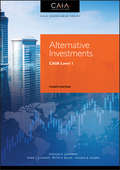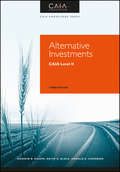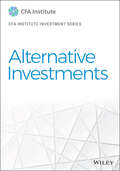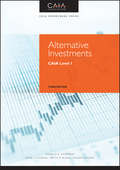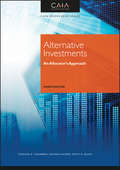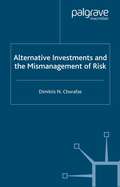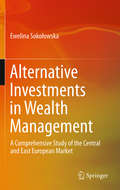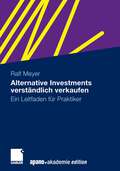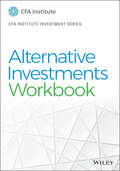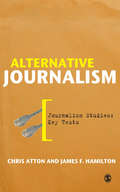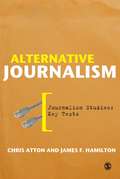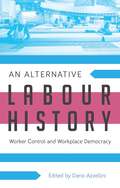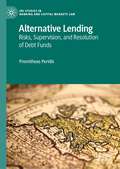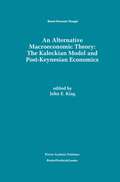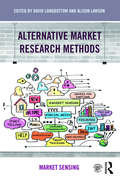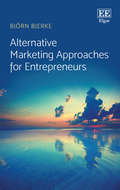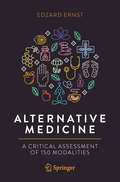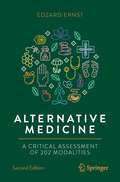- Table View
- List View
Alternative Investments: CAIA Level I (Wiley Finance)
by CAIA Association Mark J. Anson Keith H. Black Donald R. Chambers Hossein B. KazemiAlternative Investments: CAIA Level I, 4th Edition is the curriculum book for the Chartered Alternative Investment Analyst (CAIA) Level I professional examination. Covering the fundamentals of the alternative investment space, this book helps you build a foundation in alternative investment markets. You'll look closely at the different types of hedge fund strategies and the range of statistics used to define investment performance as you gain a deep familiarity with alternative investment terms and develop the computational ability to solve investment problems. From strategy characteristics to portfolio management strategies, this book contains the core material you will need to succeed on the CAIA Level I exam. This updated fourth edition tracks to the latest version of the exam and is accompanied by the following ancillaries: a workbook, study guide, learning objectives, and an ethics handbook.
Alternative Investments: CAIA Level II
by CAIA Association Hossein Kazemi Keith H. Black Donald R. ChambersIn-depth Level II exam preparation direct from the CAIA Association CAIA Level II is the official study guide for the Chartered Alternative Investment Analyst professional examination, and an authoritative guide to working in the alternative investment sphere. Written by the makers of the exam, this book provides in-depth guidance through the entire exam agenda; the Level II strategies are the same as Level I, but this time you'll review them through the lens of risk management and portfolio optimisation. Topics include asset allocation and portfolio oversight, style analysis, risk management, alternative asset securitisation, secondary market creation, performance and style attribution and indexing and benchmarking, with clear organisation and a logical progression that allows you to customise your preparation focus. This new third edition has been updated to align with the latest exam, and to reflect the current practices in the field. The CAIA designation was developed to provide a standardized knowledge base in the midst of explosive capital inflow into alternative investments. This book provides a single-source repository of that essential information, tailored to those preparing for the Level II exam. Measure, monitor and manage funds from a risk management perspective Delve into advanced portfolio structures and optimisation strategies Master the nuances of private equity, real assets, commodities and hedge funds Gain expert insight into preparing thoroughly for the CAIA Level II exam The CAIA Charter programme is rigorous and comprehensive, and the designation is globally recognised as the highest standard in alternative investment education. Candidates seeking thorough preparation and detailed explanations of all aspects of alternative investment need look no further than CAIA Level II.
Alternative Investments: CAIA Level II
by CAIA Association Hossein Kazemi Keith H. Black Donald R. ChambersIn-depth Level II exam preparation direct from the CAIA Association CAIA Level II is the official study guide for the Chartered Alternative Investment Analyst professional examination, and an authoritative guide to working in the alternative investment sphere. Written by the makers of the exam, this book provides in-depth guidance through the entire exam agenda; the Level II strategies are the same as Level I, but this time you'll review them through the lens of risk management and portfolio optimisation. Topics include asset allocation and portfolio oversight, style analysis, risk management, alternative asset securitisation, secondary market creation, performance and style attribution and indexing and benchmarking, with clear organisation and a logical progression that allows you to customise your preparation focus. This new third edition has been updated to align with the latest exam, and to reflect the current practices in the field. The CAIA designation was developed to provide a standardized knowledge base in the midst of explosive capital inflow into alternative investments. This book provides a single-source repository of that essential information, tailored to those preparing for the Level II exam. Measure, monitor and manage funds from a risk management perspective Delve into advanced portfolio structures and optimisation strategies Master the nuances of private equity, real assets, commodities and hedge funds Gain expert insight into preparing thoroughly for the CAIA Level II exam The CAIA Charter programme is rigorous and comprehensive, and the designation is globally recognised as the highest standard in alternative investment education. Candidates seeking thorough preparation and detailed explanations of all aspects of alternative investment need look no further than CAIA Level II.
Alternative Investments (CFA Institute Investment Series)
by CFA InstituteThe complete guide to alternative investments, from experts working with CFA Institute Alternative Investments is the definitive guide to understanding non-traditional asset classes. Alternatives are a disparate group of investments that are distinguished from long-only, publicly traded investments in stocks, bonds, and cash (often referred to as traditional investments). Alternative investments include real estate, commodities, infrastructure, and other non-traditional investments such as private equity or debt and hedge funds. They are attractive to investors because of the potential for portfolio diversification resulting in a higher risk-adjusted return for the portfolio. Alternative Investments and its accompanying workbook (sold separately) lead students and investment professionals through the many characteristics of non-traditional assets, including: Narrow specialization of the investment managers Relatively low correlation of returns with those of traditional investments Less regulation and less transparency than traditional investments Limited historical risk and return data Unique legal and tax considerations Higher fees, often including performance or incentive fees Concentrated portfolios Restrictions on redemptions (i.e. “lockups” and “gates”) CFA Institute is the world's premier association for investment professionals, and the governing body for the CFA® Program, CIPM® Program, CFA Institute ESG Investing Certificate, and Investment Foundations® Program. Those seeking a deeper understanding of the markets, mechanisms, and use of alternatives will value the level of expertise CFA Institute brings to the discussion, providing a clear, comprehensive resource for students and professionals alike. Whether used alone or in conjunction with the companion workbook, Alternative Investments offers a complete course in alternative investments and their role in investment management.
Alternative Investments (CFA Institute Investment Series)
by CFA InstituteThe complete guide to alternative investments, from experts working with CFA Institute Alternative Investments is the definitive guide to understanding non-traditional asset classes. Alternatives are a disparate group of investments that are distinguished from long-only, publicly traded investments in stocks, bonds, and cash (often referred to as traditional investments). Alternative investments include real estate, commodities, infrastructure, and other non-traditional investments such as private equity or debt and hedge funds. They are attractive to investors because of the potential for portfolio diversification resulting in a higher risk-adjusted return for the portfolio. Alternative Investments and its accompanying workbook (sold separately) lead students and investment professionals through the many characteristics of non-traditional assets, including: Narrow specialization of the investment managers Relatively low correlation of returns with those of traditional investments Less regulation and less transparency than traditional investments Limited historical risk and return data Unique legal and tax considerations Higher fees, often including performance or incentive fees Concentrated portfolios Restrictions on redemptions (i.e. “lockups” and “gates”) CFA Institute is the world's premier association for investment professionals, and the governing body for the CFA® Program, CIPM® Program, CFA Institute ESG Investing Certificate, and Investment Foundations® Program. Those seeking a deeper understanding of the markets, mechanisms, and use of alternatives will value the level of expertise CFA Institute brings to the discussion, providing a clear, comprehensive resource for students and professionals alike. Whether used alone or in conjunction with the companion workbook, Alternative Investments offers a complete course in alternative investments and their role in investment management.
Alternative Investments: CAIA Level I (Wiley Finance #194)
by Donald R. Chambers Mark J. Anson Keith H. Black Hossein Kazemi CAIA AssociationThe official CAIA Level 1 curriculum bookAlternative Investments: CAIA Level I, 3rd Edition is the curriculum book for the Chartered Alternative Investment Analyst (CAIA) Level I professional examination. Covering the fundamentals of the alternative investment space, this book helps you build a foundation in alternative investment markets. You'll look closely at the different types of hedge fund strategies and the range of statistics used to define investment performance as you gain a deep familiarity with alternative investment terms and develop the computational ability to solve investment problems. From strategy characteristics to portfolio management strategies, this book contains the core material you will need to succeed on the CAIA Level I exam. This updated third edition tracks to the latest version of the exam, and is accompanied by the following ancillaries: a workbook, study guide, learning objectives, and an ethics handbook. Most investment analyst education programs focus primarily on the traditional asset classes, pushing alternative investments to the sidelines. The CAIA designation was developed in response to the tremendous growth of alternative investing, and is the industry's premier educational standard. This book is your official study companion, bringing you fully up to speed on everything you need to know (with the exception of the ethics material covered in a separate handbook). Understand the complexities of each alternative asset class Learn the quantitative techniques professionals use every day Dig into the unique aspects of alternative investments Master the core material covered by the CAIA Level I exam More than 300 financial institutions and hedge funds have committed key executives to the CAIA exam, and this rapidly growing trend speaks to the designation's rising status as a must-have credential for anyone in the alternative investment sphere. Increase your chances of success by getting your information straight from the source in CAIA Level I.
Alternative Investments: CAIA Level I (Wiley Finance)
by Donald R. Chambers Mark J. Anson Keith H. Black Hossein Kazemi CAIA AssociationThe official CAIA Level 1 curriculum bookAlternative Investments: CAIA Level I, 3rd Edition is the curriculum book for the Chartered Alternative Investment Analyst (CAIA) Level I professional examination. Covering the fundamentals of the alternative investment space, this book helps you build a foundation in alternative investment markets. You'll look closely at the different types of hedge fund strategies and the range of statistics used to define investment performance as you gain a deep familiarity with alternative investment terms and develop the computational ability to solve investment problems. From strategy characteristics to portfolio management strategies, this book contains the core material you will need to succeed on the CAIA Level I exam. This updated third edition tracks to the latest version of the exam, and is accompanied by the following ancillaries: a workbook, study guide, learning objectives, and an ethics handbook. Most investment analyst education programs focus primarily on the traditional asset classes, pushing alternative investments to the sidelines. The CAIA designation was developed in response to the tremendous growth of alternative investing, and is the industry's premier educational standard. This book is your official study companion, bringing you fully up to speed on everything you need to know (with the exception of the ethics material covered in a separate handbook). Understand the complexities of each alternative asset class Learn the quantitative techniques professionals use every day Dig into the unique aspects of alternative investments Master the core material covered by the CAIA Level I exam More than 300 financial institutions and hedge funds have committed key executives to the CAIA exam, and this rapidly growing trend speaks to the designation's rising status as a must-have credential for anyone in the alternative investment sphere. Increase your chances of success by getting your information straight from the source in CAIA Level I.
Alternative Investments: An Allocator's Approach (Wiley Finance Ser.)
by Donald R. Chambers Hossein B. Kazemi Keith H. Black CAIA AssociationWhether you are a seasoned professional looking to explore new areas within the alternative investment arena or a new industry participant seeking to establish a solid understanding of alternative investments, Alternative Investments: An Allocator's Approach, Fourth Edition (CAIA Level II curriculum official text) is the best way to achieve these goals. In recent years, capital formation has shifted dramatically away from public markets as issuers pursue better financial and value alignment with ownership, less onerous and expensive regulatory requirements, market and information dislocation, and liberation from the short-term challenges that undergird the public capital markets. The careful and informed use of alternative investments in a diversified portfolio can reduce risk, lower volatility, and improve returns over the long-term, enhancing investors' ability to meet their investment outcomes. Alternative Investments: An Allocator's Approach (CAIA Level II curriculum official text) is a key resource that can be used to improve the sophistication of asset owners and those who work with them. This text comprises the curriculum, when combined with supplemental materials available at caia.org, for the CAIA Level II exam. "Over the course of my long career one tenet has held true, 'Continuing Education'. Since CalSTRS is a teachers' pension plan, it is no surprise that continuing education is a core attribute of our Investment Office culture. Overseeing one of the largest institutional pools of capital in the world requires a cohesive knowledge and understanding of both public and private market investments and strategies. We must understand how these opportunities might contribute to delivering on investment outcomes for our beneficiaries. Alternative Investments: An Allocator's Approach is the definitive core instruction manual for an institutional investor, and it puts you in the captain's chair of the asset owner."—Christopher J. Ailman, Chief Investment Officer, California State Teachers’ Retirement System "Given their diversified cash flow streams and returns, private markets continue to be a growing fixture of patient, long-term portfolios. As such, the need to have proficiency across these sophisticated strategies, asset classes, and instruments is critical for today's capital allocator. As a proud CAIA charterholder, I have seen the practical benefits in building a strong private markets foundation, allowing me to better assist my clients."—Jayne Bok, CAIA, CFA, Head of Investments, Asia, Willis Tower Watson
Alternative Investments: An Allocator's Approach (Wiley Finance Ser.)
by Donald R. Chambers Hossein B. Kazemi Keith H. Black CAIA AssociationWhether you are a seasoned professional looking to explore new areas within the alternative investment arena or a new industry participant seeking to establish a solid understanding of alternative investments, Alternative Investments: An Allocator's Approach, Fourth Edition (CAIA Level II curriculum official text) is the best way to achieve these goals. In recent years, capital formation has shifted dramatically away from public markets as issuers pursue better financial and value alignment with ownership, less onerous and expensive regulatory requirements, market and information dislocation, and liberation from the short-term challenges that undergird the public capital markets. The careful and informed use of alternative investments in a diversified portfolio can reduce risk, lower volatility, and improve returns over the long-term, enhancing investors' ability to meet their investment outcomes. Alternative Investments: An Allocator's Approach (CAIA Level II curriculum official text) is a key resource that can be used to improve the sophistication of asset owners and those who work with them. This text comprises the curriculum, when combined with supplemental materials available at caia.org, for the CAIA Level II exam. "Over the course of my long career one tenet has held true, 'Continuing Education'. Since CalSTRS is a teachers' pension plan, it is no surprise that continuing education is a core attribute of our Investment Office culture. Overseeing one of the largest institutional pools of capital in the world requires a cohesive knowledge and understanding of both public and private market investments and strategies. We must understand how these opportunities might contribute to delivering on investment outcomes for our beneficiaries. Alternative Investments: An Allocator's Approach is the definitive core instruction manual for an institutional investor, and it puts you in the captain's chair of the asset owner."—Christopher J. Ailman, Chief Investment Officer, California State Teachers’ Retirement System "Given their diversified cash flow streams and returns, private markets continue to be a growing fixture of patient, long-term portfolios. As such, the need to have proficiency across these sophisticated strategies, asset classes, and instruments is critical for today's capital allocator. As a proud CAIA charterholder, I have seen the practical benefits in building a strong private markets foundation, allowing me to better assist my clients."—Jayne Bok, CAIA, CFA, Head of Investments, Asia, Willis Tower Watson
Alternative Investments and the Mismanagement of Risk
by D. Chorafas'Investors beware' is good advice in any situation, especially when dealing with the control of risk and alternative investments. In this book Chorafas has uncovered the hidden risks behind alternative investments through extensive research in the US, UK, Germany France, Italy Scandinavia and Switzerland. He also provides solutions to the problems identified. This book is particularly important in light of recent scandals such as Enron and WorldCom.
Alternative Investments in Wealth Management: A Comprehensive Study of the Central and East European Market
by Ewelina SokołowskaThis monograph provides a comprehensive source of analysis and research on alternative investments in the wealth management process, with a special focus on Poland and Eastern Europe. It presents the characteristics that distinguish alternative investments from traditional investments and illustrates the benefits and risks involved in the former. The experience gained in developed countries is extremely valuable for the analysis of both the Polish and Eastern European financial markets. In the theoretical part of the book, key aspects of alternative investments are collected, systematized and developed; subsequently, in the empirical part the results of selected studies on the alternative investment sector around the world are examined. Lastly, the book’s findings are applied to the context of alternative financial investments in Poland, investigating the preferences for alternative investments in the country, which is the largest market in Central and Eastern Europe. Not only of theoretical interest, these insights have a high application value, making the book an essential resource for scholars, practitioners and policymakers alike.
Alternative Investments verständlich verkaufen: Ein Leitfaden für Praktiker
by Ralf MeyerBasis für eine kundenorientierte Beratung sind eine hervorragende Fachkompetenz und ein guter Einblick in wirtschaftliche Zusammenhänge. Genauso entscheidend ist dann jedoch, dass diese Informationen anlegergerecht vermittelt werden. Der Kunde soll in die Lage versetzt werden, die Tragweite seiner Entscheidungen einschätzen zu können. Somit sind Transparenz, Nachvollziehbarkeit und Verständlichkeit die Schlüsselfaktoren. Dieses Buch liefert Ihnen viele Ideen und Anregungen für Ihre Beratungsgespräche. Sie erhalten praxiserprobte Ratschläge, wie es Ihnen hervorragend gelingen kann, in einem schwierigen Umfeld Geschäftsmöglichkeiten zu entdecken und zu nutzen.
Alternative Investments Workbook (CFA Institute Investment Series)
by CFA InstituteHands-on practice with alternative investments based on real-world scenarios Alternative Investments Workbook provides the key component of effective learning—practice. Designed for both students and investment professionals, this companion workbook conveniently aligns with the Alternative Investments text chapter-by-chapter, offers brief chapter summaries to refresh your memory on key points before you begin working, and explicitly lays out the learning objectives so you understand the “why” of each problem. This workbook helps you: Synthesize essential material from the Alternative Investments text using real-world applications Understand the key characteristics of non-traditional investments Work toward specific chapter objectives to internalize important information CFA Institute is the world's premier association for investment professionals, and the governing body for the CFA® Program, CIPM® Program, CFA Institute ESG Investing Certificate, and Investment Foundations® Program. Those seeking a deeper understanding of the markets, mechanisms, and use of alternatives will value the level of expertise CFA Institute brings to the discussion as well as the extra practice delivered in Alternative Investments Workbook based on real scenarios investors face every day.
Alternative Investments Workbook (CFA Institute Investment Series)
by CFA InstituteHands-on practice with alternative investments based on real-world scenarios Alternative Investments Workbook provides the key component of effective learning—practice. Designed for both students and investment professionals, this companion workbook conveniently aligns with the Alternative Investments text chapter-by-chapter, offers brief chapter summaries to refresh your memory on key points before you begin working, and explicitly lays out the learning objectives so you understand the “why” of each problem. This workbook helps you: Synthesize essential material from the Alternative Investments text using real-world applications Understand the key characteristics of non-traditional investments Work toward specific chapter objectives to internalize important information CFA Institute is the world's premier association for investment professionals, and the governing body for the CFA® Program, CIPM® Program, CFA Institute ESG Investing Certificate, and Investment Foundations® Program. Those seeking a deeper understanding of the markets, mechanisms, and use of alternatives will value the level of expertise CFA Institute brings to the discussion as well as the extra practice delivered in Alternative Investments Workbook based on real scenarios investors face every day.
Alternative Journalism
by Dr James F. Hamilton Professor Chris Atton"A provocative, inspiring and challenging intervention in both journalism and media studies.... Alternative Journalism is that rare book that services students as much as scholars. It widens the trajectory of media studies and creates different modes of reading, writing and thinking... It offers an alternative history beyond the tales of great men, great newspapers, great editors and great technologies. It adds value and content to overused and ambiguous words such as "community" and "citizenship" and captures the spark of new information environments." - THE, (Times Higher Education) Alternative Journalism investigates and analyses the diverse forms and genres of journalism that have arisen as challenges to mainstream news coverage. From the radical content of emancipatory media to the dizzying range of citizen journalist blogs and fanzine subcultures, this book charts the historical and cultural practices of this diverse and globalized phenomenon. This exploration goes to the heart of journalism itself, prompting a critical inquiry into the epistemology of news, the professional norms of objectivity, the elite basis of journalism and the hierarchical commerce of news production. In investigating the challenges to media power presented by alternative journalism, Atton addresses not just the issues of politics and empowerment but also the journalism of popular culture and the everyday. The result is essential reading for students of journalism - both mainstream and alternative.
Alternative Journalism (PDF)
by Dr James F. Hamilton Professor Chris Atton"A provocative, inspiring and challenging intervention in both journalism and media studies.... Alternative Journalism is that rare book that services students as much as scholars. It widens the trajectory of media studies and creates different modes of reading, writing and thinking... It offers an alternative history beyond the tales of great men, great newspapers, great editors and great technologies. It adds value and content to overused and ambiguous words such as "community" and "citizenship" and captures the spark of new information environments." - THE, (Times Higher Education) Alternative Journalism investigates and analyses the diverse forms and genres of journalism that have arisen as challenges to mainstream news coverage. From the radical content of emancipatory media to the dizzying range of citizen journalist blogs and fanzine subcultures, this book charts the historical and cultural practices of this diverse and globalized phenomenon. This exploration goes to the heart of journalism itself, prompting a critical inquiry into the epistemology of news, the professional norms of objectivity, the elite basis of journalism and the hierarchical commerce of news production. In investigating the challenges to media power presented by alternative journalism, Atton addresses not just the issues of politics and empowerment but also the journalism of popular culture and the everyday. The result is essential reading for students of journalism - both mainstream and alternative.
An Alternative Labour History: Worker Control and Workplace Democracy
by Dario AzzelliniThe global financial crisis has led to a new shop-floor militancy. Radical forms of protest and new workers' takeovers have sprung up all over the globe. In the US, Republic Windows and Doors started production under worker control in January 2013. Later that year workers in Greece took over and managed a hotel, a hospital, a newspaper, a TV channel and a factory.The dominant revolutionary left has viewed workers' control as part of a system necessary during a transition to socialism. Yet most socialist and communist parties have neglected to promote workers' control as it challenges the centrality of parties and it is in this spirit that trade unions, operating through the institutional frameworks of government, have held a monopoly over labor history.Tracing Marx's writings on the Paris Commune through council communism, anarcho-syndicalism, Italian operaismo, and other "heretical" left currents, An Alternative Labour History uncovers the practices and intentions of historical and contemporary autonomous workers' movements that until now have been largely obscured. It shows that by bringing permanence and predictability to their workplaces, workers can stabilize their communities through expressions of participatory democracy. And, as history has repeatedly shown, workers have always had the capacity to run their enterprises on their own.
An Alternative Labour History: Worker Control and Workplace Democracy
by Dario AzzelliniThe global financial crisis has led to a new shop-floor militancy. Radical forms of protest and new workers' takeovers have sprung up all over the globe. In the US, Republic Windows and Doors started production under worker control in January 2013. Later that year workers in Greece took over and managed a hotel, a hospital, a newspaper, a TV channel and a factory.The dominant revolutionary left has viewed workers' control as part of a system necessary during a transition to socialism. Yet most socialist and communist parties have neglected to promote workers' control as it challenges the centrality of parties and it is in this spirit that trade unions, operating through the institutional frameworks of government, have held a monopoly over labor history.Tracing Marx's writings on the Paris Commune through council communism, anarcho-syndicalism, Italian operaismo, and other "heretical" left currents, An Alternative Labour History uncovers the practices and intentions of historical and contemporary autonomous workers' movements that until now have been largely obscured. It shows that by bringing permanence and predictability to their workplaces, workers can stabilize their communities through expressions of participatory democracy. And, as history has repeatedly shown, workers have always had the capacity to run their enterprises on their own.
Alternative Lending: Risks, Supervision, and Resolution of Debt Funds (EBI Studies in Banking and Capital Markets Law)
by Promitheas PeridisThe book covers alternative lending using the emergence of Debt Funds in the EU as a case study. The book explores the risks that they can pose to financial stability, and the regulatory and supervisory tools available to mitigate these risks. Through this analysis, the book uncovers the risks and potential risk mitigation tools that can be applied to the alternative lenders–including debt funds and other potential alternative lenders. After identifying the reasons behind the growth of alternative lenders (using as example the assets of Alternative Investment Funds (AIFs) and in particular debt funds) and the simultaneous decrease of the banks’ assets, the book analyses the systemic importance of the alternative lenders and the risk channels through which the systemic risk can spread to the banking sector and the financial system. Then, the book deals with the financial innovation-market failure theory and demonstrates that financial innovations (e.g. debt funds, securitisations) can cause market failures, resulting in regulatory interventions. Of interest to banking and financial regulation academics, researchers, and practitioners this book analyses the regulatory provisions in place for both credit institutions and debt funds, including the Basel Accords, the Capital Requirements Directives and Regulations, and the Alternative Investment Fund Managers Directive (AIFMD) and its implementation in various EU jurisdictions, before offering a proposal for a new three-defensive framework applicable to debt funds and to other potential alternative lenders.
An Alternative Macroeconomic Theory: The Kaleckian Model and Post-Keynesian Economics (Recent Economic Thought #49)
by John E. KinglE. King Michael Kalecki (1899-1970) was one of the most important, and also one of the most underrated, economists of the twentieth century. In the 1930s he made a series of fundamental contributions to macroeconomic theory which anticipated, complemented and in some ways surpassed those of Keynes. Almost entirely self-educated in economics, and influenced rul much by Marxism as by mainstream theory, Kalecki very largely escaped the fatal embrace of pre-Keynesian orthodoxy, which blunted the thrust of the General Theory. Many Post Keynesians, in particular, have found in his work the elements of a convincing alternative to what Joan Robinson -Kalecki's greatest advocate in the English-speaking world - was scathingly to describe as 'bastard Keynesianism' . But Kalecki was never interested in theory for its own sake. He approached economics from a practical perspective, wrote extensively on applied and policy questions, and in the [mal decades of his life turned his attention increasingly to problems of economic development and the management of state socialist economies.
Alternative Market Research Methods: Market Sensing
by David Longbottom Alison LawsonTraditional research methods in marketing can be illuminating when used well, but all too often their data-driven results fail to provide the depth of understanding that organisations need to anticipate market needs. Alternative Market Research Methods: Market sensing is a new approach that enables researchers to get greater depth and meaning from their research and organisations to make smarter strategic decisions. This book, the first text dedicated to the topic, explains market sensing simply and practically and demonstrates how it can benefit researchers. It teaches non-mainstream and alternative research methods which facilitate innovative research design, and achieves deep insights into the mindsets of consumers. The methods explored in this book include: emotional scaling ; discourse analysis; consumer ethnography; social media networks; narrative and story telling; gamification. With a wealth of case studies and pedagogy to aid student learning, as well as online teaching aids including PowerPoint presentations and video content, this ground-breaking textbook is an essential resource for anyone that wants to expand their repertoire of marketing research methods to create a research project that will be original and insightful.
Alternative Market Research Methods: Market Sensing
by David Longbottom Alison LawsonTraditional research methods in marketing can be illuminating when used well, but all too often their data-driven results fail to provide the depth of understanding that organisations need to anticipate market needs. Alternative Market Research Methods: Market sensing is a new approach that enables researchers to get greater depth and meaning from their research and organisations to make smarter strategic decisions. This book, the first text dedicated to the topic, explains market sensing simply and practically and demonstrates how it can benefit researchers. It teaches non-mainstream and alternative research methods which facilitate innovative research design, and achieves deep insights into the mindsets of consumers. The methods explored in this book include: emotional scaling ; discourse analysis; consumer ethnography; social media networks; narrative and story telling; gamification. With a wealth of case studies and pedagogy to aid student learning, as well as online teaching aids including PowerPoint presentations and video content, this ground-breaking textbook is an essential resource for anyone that wants to expand their repertoire of marketing research methods to create a research project that will be original and insightful.
Alternative Marketing Approaches for Entrepreneurs
by Björn BjerkeConsumers have, to a large extent, become their own producers; they are more aware of marketing and are active in adding value to the products and experiences they want. By assessing customers as active agents rather than passive consumers, Björn Bjerke explores alternative ways of marketing for new businesses and social entrepreneurial ventures. This book first presents the dominant approach to marketing theory used for the last half a century. After that, it presents an alternative approach to marketing theory by emphasizing how new infrastructures and organizations, including online platforms, influence new ways of linking the formal and informal economies together. Building on fundamental theories of science and methodological issues, Bjerke creates useful theoretical conceptions that can develop a greater connection between practice and research. He argues that as entrepreneurial activity is more accessible than ever it needs a fresh approach to include customers as co-creators and co-extractors of market value. An excellent book for exploring alternative marketing, students and researchers in marketing, social entrepreneurship and wider business and management studies will gain a greater understanding of what it means to be a marketer, customer and user.
Alternative Medicine: A Critical Assessment of 150 Modalities
by Edzard ErnstAlternative medicine (AM) is hugely popular; about 40% of the US general population have used at least one type of alternative treatment in the past year, and in Germany this figure is around 70%. The money spent on AM is considerable: the global market is expected to reach nearly US $ 200 billion by 2025, with most of these funds coming directly out of consumers’ pockets. The reasons for this popularity are complex, but misinformation is certainly a prominent factor. The media seem to have an insatiable appetite for the subject and often report uncritically on it. Misinformation about AM on the Internet (currently about 50 million websites are focused on AM) is much more the rule than the exception. Consumers are thus being bombarded with misinformation on AM, and they are ill-protected from such misinformation and therefore prone to making wrong, unwise or dangerous therapeutic decisions, endangering their health and wasting their money. This book is a reference text aimed at guiding consumers through the maze of AM. The concept of the book is straightforward. It has two main parts. The first, short section provides essential background on AM, explaining in simple terms what is (and what is not) good, reliable evidence, and addressing other relevant issues like, for instance, the placebo response, informed consent, integrative medicine, etc. The second and main part consists of 150 short chapters, topically grouped and each dedicated to one single alternative therapeutic or diagnostic method. In each of them, seven critical points are raised. These points relate to issues that are important for consumers’ decisions whether it is worth trying the method in question. Restricting the discussion to just seven points means that issues must be prioritized to those themes which are most relevant in the context of each given modality.
Alternative Medicine: A Critical Assessment of 202 Modalities (Copernicus Books)
by Edzard ErnstAlternative medicine (AM) is popular; about 40% of the US general population have used alternative treatment in the past year, and in Germany this figure is around 70%. The global market is expected to reach nearly US $ 200 billion by 2025, with most of these funds coming directly out of consumers’ pockets. Consumers are bombarded with misleading and false information on AM and therefore prone to making wrong, unwise, or dangerous therapeutic decisions, endangering their health and wasting their money. This book is a reference text aimed at guiding consumers through the maze of AM. This second edition includes over 50 additional treatments as well as updates on many others.
